英语写作基础教程课件
英语写作教程(第一册)课件L3 sentence basics

(2)Compounding Compounding means using more than one of the basic sentence elements to expand a sentence.
Basic:He enjoyed dances.
Expanded: He and his wife enjoyed dances, parties and concerts. Basic: The boy was yelling. Expanded: The boy was yelling and crying.
Dependent clauses can be classified into adjective clause, adverb clause, and noun clause.
➢ Adjective clauses, sometimes called relative clauses(关系分句), modify nouns or pronouns and always follow the nouns or pronouns.
➢ Sometimes, though, a simple subject even can be an entire clause.
What he had already forgotten about computer repair could fill whole volumes.
2. Predicate
2)Dependent clause(从属分句) A subordinate clause. An dependent clause can not stand alone and needs to be attached to an independent clause.
基础英语写作IPPT课件

Vocabulary 6:
(1) colossal (2) restore (3)
enchantment (4) startling (5) authentic
(6) carnival (7) immaculate (8) wreck
(9) reluctant (10) infamous (11)
写作的视角和意识,培养和锻炼逻辑思
维和思辨能力以及综合应用基本英语知
识和技巧的能力,对书信、散文、小说、
评论等文体分步骤、分阶段地展开实践
性训练。
3
具体说来,其目标包括:
(一)知识
1)熟悉并掌握经典英文电影的
故事设置、人物情感表述方式;
2)细读、分析和消化英国散文
优秀篇章的写作风格和语言特
点;
3)欣赏、评价并吸收英文著名
13
(三)第六单元第3部分2学时 提前阅读: 1、《英国散文的流变》第八章 二十世纪 (下) “两本游记”、“新品种:广播 与电视上的散文”、“口述历史”,第九 章 结束语, 第六章 十九世纪“历史想象 力的发挥”、“说理散文的各种表现”、 “纽曼的信仰危机”、“密尔的自由观”; 2、阅读English Short Story Writing, Unit 1 Fiction: the Short Story.
consternation (12) weary (13) evasive
(14) obstacle (15) downfall (16) stir
(17) hideous (18) prolong (19) deface
(20) manifold (21) distress (22) proof
(23) desolation (24) mourning (25)
英语写作课件ppt

写作风格和语言选择
写作风格
根据文章目的和读者选择适当的写作 风格,如正式、非正式、商业或个人 风格。
语言选择
使用准确、清晰、简洁的语言,避免 语法和拼写错误,确保表达的流畅性 和准确性。
文章结构和段落组织
文章结构
合理安排文章开头、主体和结尾,确保内容逻辑清晰、条理 分明。
段落组织
分段合理,每段主题明确,段与段之间过渡自然,避免内容 重复或脱节。
为了避免句子结构过于单一,作者可以使用不同的句型和表达方式,如并列句 、复合句、倒装句等。同时,避免句子冗长,将长句拆分成短句,使文章更加 易于阅读和理解。
缺乏连贯性和逻辑性
总结词
文章缺乏连贯性和逻辑性会影响读者的阅读体验和理解。
详细描述
为了提高文章的连贯性和逻辑性,作者需要合理安排段落和布局,使用过渡词和短语来连接句子和段落,使文章 更加流畅。同时,注意文章的主题和论点,确保文章内容紧扣主题,条理清晰。
使用修辞手法和表达方式
比喻
通过比喻来描述抽象概 念或事物,使读者更易
理解。
拟人
将非人类事物人格化, 增强描述的生动性。
排比
使用三个或以上结构相 似的句子,增强语势。
倒装
打破常规语序,使句子 结构更加丰富多样。
提高文章深度和广度
01
02
03
04
深度
通过深入挖掘主题,分析其内 在联系和影响,使文章更具深
使用过渡词和过渡句, 增强段落之间的逻辑连 接。
过渡词和过渡句的使用 能够使段落之间的逻辑 连接更加紧密。通过使 用合适的过渡词和过渡 句,可以引导读者的思 路,使文章更加连贯、 流畅。
03
英语写作常见问题及解决方案
《英语写作基础教程》讲义-英语写作基础教程
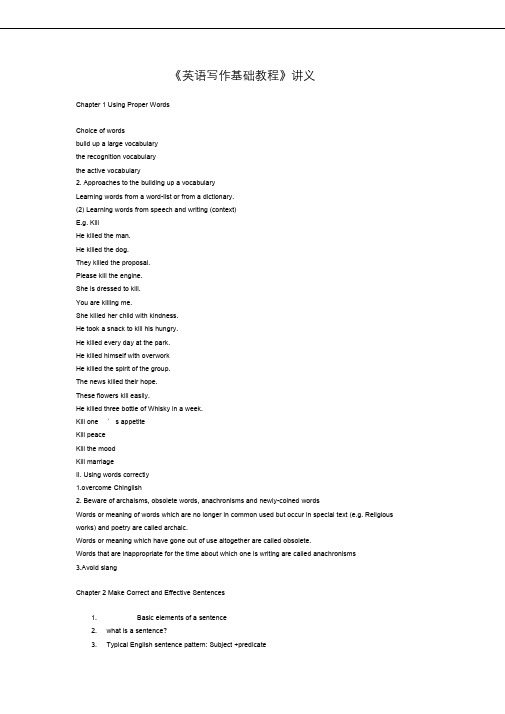
《英语写作基础教程》讲义Chapter 1 Using Proper WordsChoice of wordsbuild up a large vocabularythe recognition vocabularythe active vocabulary2. Approaches to the building up a vocabularyLearning words from a word-list or from a dictionary.(2) Learning words from speech and writing (context)E.g. KillHe killed the man.He killed the dog.They killed the proposal.Please kill the engine.She is dressed to kill.You are killing me.She killed her child with kindness.He took a snack to kill his hungry.He killed every day at the park.He killed himself with overworkHe killed the spirit of the group.The news killed their hope.These flowers kill easily.He killed three bottle of Whisky in a week.Kill one ’s appetiteKill peaceKill the moodKill marriageII. Using words correctly1.overcome Chinglish2. Beware of archaisms, obsolete words, anachronisms and newly-coined wordsWords or meaning of words which are no longer in common used but occur in special text (e.g. Religious works) and poetry are called archaic.Words or meaning which have gone out of use altogether are called obsolete.Words that are inappropriate for the time about which one is writing are called anachronisms3.Avoid slangChapter 2 Make Correct and Effective Sentences1. Basic elements of a sentence2. what is a sentence?3. Typical English sentence pattern: Subject +predicateCoach Dietz exemplified this behavior by walking offthe field in the middle of a game , l eaving her team ata time when we needed her.I need to find a new roommate. I need to find a new roommatehave now isn't working out too well have now isn't working out too well.Well done! What a day!George in Beijing ? Susan a singer?To return from our digressionA run-on sentence consists of two or moresentence —or a semicolon.)Comma splices join two complete sentences with a comma.”and “he needed to buy eggs for Joey went to the grocery store, for he needed to buy eggs for supper.3. The position of modifiers(2) Reference of person(3) Vague ComparisonIV. Coherence(5) The balanced sentenceVI. The kinds of sentencesIn structure: (1) a simple sentence(2) a compound sentence(3) a complex sentence(4) exclamatoryRhetorically:Loose SentencePeriodic sentenceThe balance sentenceThe cumulative sentenceThe anticlimactic sentenceRhetorical questionA. Declarative, Interrogative, Imperative and Exclamatory SentencesAccording to their use, sentences are declarative, interrogative, imperative or exclamatory. A declarative sentence makes an assertion or a statement. An interrogative sentence asks a question. An imperative sentence expresses a command or a request. An exclamatory sentence expresses a strong feeling or emotion, such as surprise, pain, or joy.B. Simple, Compound, Complex, and Compound-Complex SentencesAccording to their structure, sentences are simple, compound, complex, or compound-complex.SIMPLE SENTENCEA simple sentence has only one subject and one predicate-verb, but it may contain more than one object, attribute or adverb. Short simple sentences are usually emphatic; they have special clarity and provide variety when used with longer sentences.e.g. 1. He is a good student.2. Would you tell the way to the Astor Hotel?3. Do not disturb your brother!4. When did you join the club?5. What a lovely girl she is!COMPOUND SENTENCEA compound sentence consists of two or more independent clauses (or simple sentences) related toeach other in meaning, and linked by a coordinating conjunction (and, but, or, so, for, etc.) or by a semicolon without a conjunction. Coordinated ideas should be compatible and roughly equal in importance, or take shape one by one in orderly sequence.e.g. 1. The heavy rain started suddenly, so we stopped planting the trees.2. Jack wanted to go swimming, but his wife wanted to go shopping.3. Her son studies History; her daughter majors in Chemistry.COMPLEX SENTENCEA complex sentence contains one main (or principal) clause and one or more dependent (or subordinate) clauses, with a connective word denoting the relation between the two parts. The dependent clause mayplay the part of a subject, an object, a predicative, an attribute, or an adverbial in the main clause. As arule, the major idea is expressed in the main clause and the idea or ideas of lesser importance in the subordinate clauses.e.g. 1. The government banned the high-blood-pressure pills because they produced side effects.2. Although the shop advertised same-day service, my car was not ready for three days.3. These apple trees, which my father planted three years ago, have not borne any fruit.COMPOUND-COMPLEX SENTENCEA compound-complex sentence contains at least two main clauses and at least one dependentclause —a combination of a compound and a complex sentence.e.g. 1. After I returned to school following a long illness, the math teacher gave me make-up work, but the history teacher made me drop her course.2. When the power line snapped, Tom was listening to the stereo, and Teresa was reading in bed.3. Lisa disliked walking home from the bus stop, because the street had no overhead light and it was lined with abandoned buildings.C. Loose and Periodic SentencesA loose sentence puts the main idea before all supplementary information; in other words, it puts first things first, and lets the reader know what it is mainly about when he has read the first few words. The reverse arrangement makes a periodic sentence: the main idea is expressed at or near the end of it, and it is not grammatically complete until the end is reached. The reader does not know what it is mainly about until he finishes reading it.Compare:1. She was offered a professional contract after winning the Olympic gold medal for figure skating, according to newspaper reports.2. According to newspaper reports, after winning the Olympic gold medal for figure skating, she was offered a professional contract.The main idea of both sentences is the fact that she was offered a professional contract. This idea is put at the beginning of the first sentence and at the end of the second, thus making one a loose sentence and the other a periodic one. Besides, the first part of the first sentence is complete in structure, but that of the second are only prepositional phrases and cannot be called a sentence without the second part. Loose sentences are easier, simpler, more natural and direct; periodic sentences are more complex, emphatic, formal, or literary.D. Short and Long SentencesShort sentences are usually emphatic, whereas long sentences are capable of expressing complex ideas with precision, because it may contain many modifiers. Short sentences are suitable for the presentation of important facts and ideas, and long sentences for the explanation of views and theories, or the description of things with many details.The following passage, which describes how a man saved a drowning girl, makes good use of short sentences.He crouched a little, spreading his hand under the water and moving them round, trying to feel for her. The dead cold pond swayed upon his chest. He moved again, a little deeper, and again, with his hands underneath, he felt all around under the water. And he touched her clothing. But it evaded his fingers. He made a desperate effort to grasp it ⋯He laid her down on the bank. She was quite unconscious and running with water. He made the watercome from her mouth, he worked to restore her. He did not have to work very long before he could feelthe breathing begin again in her; she was breathing naturally. He worked a little longer. He could feel herlive beneath his hands; she was coming back. He wiped her face, wrapped her in his overcoat, lookedround into the dim, dark gray world, then lift her and staggered down the bank and across the fields.---D. H. LawrenceIn contrast to short sentences, long sentences are particularly useful for presenting a set of complex,interlocking ideas. They are common in legal, political and theoretical writing, which depends onmodification for accuracy. In fiction long sentences are sometimes used to describe a person, a thing or ascene.Mrs. Chalmers was kind of fat and her hair was pretty blond and her complexion was soft and pink andshe always looked as though she had been in the beauty parlor all afternoon. She always said “My, you’re getting to be a big boy ”to Peter when she met him in the elevator, in a soft voice, as though shewas just about to laugh. She must have said that fifty times by now. She had a good, strong smell ofperfume on her all the time, too.Mr. Chalmers wore pince-nez glasses most of the time and he was getting bald and he worked late at hisoffice a good many evenings of the week. When he met Peter in the elevator he would say, “It ’s getting colder, ”or “It ’s getting warmer, ”and that was all, so Peter had no opinion about him, except that helooked like the principal of a school.But now Mrs. Chalmers was on her knees in the vestibule and her dress was torn and she was crying andthere were black streaks on her cheeks and she didn ’t look as though she ’d just come from the beauty parlor. And Mr. Chalmers wasn ’t wearing a jacket and he didn ’t have his glasses on and whaht a h d a i r hewas mussed all over his head and he was leaning against the Early American wallpaper making thisanimal noise, and he had a big, heavy pistol in his hand and he was pointing it right at Mrs. Chalmers.---Irwin ShawAlthough series of short and long sentences can both be effective in individual situations, frequentalternation in sentence length characterize much memorable writing. After one or more long sentencesthat express complex ideas or images, the pitch of a short sentence can be refreshing. Look at thefollowing example:We are now so easily misled by vision. Most of the things before our eyes are plainly there, notmistakable for other things except for the illusions created by professional magicians and, sometimes,the look of the light of downtown New York against a sky so black as to make it seem a near view ofeternity. Our eyes are not easy to fool.Similarly, a long sentence that follows a series of short ones can serve as a climax or summing-up thatrelaxes the tension or fulfills that expectation created by the series, giving readers a sense of completion.Here is a good example:We now have, as a result of modern means of communication, hundreds of words flung at us daily. Weare constantly being talked at, by teachers, preachers, salesmen, public officials, and motion-picturesound tracks. The cries of advertisers pursue us into our very home, thanks to the TV —and in somehouses the TV is never turned off from morning to night. Daily the newsboy brings us, in large cities, from thirty to fifty enormous pages of print, and almost three times that amount on Sunday. We go out and get more words at bookstores and libraries. Words fill our lives.VII. sentence varietyChapter 3 Developing ParagraphsChapter 3 Developing Paragraphs1. Basic structure of paragraphsTopic sentence:It states the main idea of the paragraph. It not only names the topic of the paragraph, but it also limits the topic to one or two areas that can be discussed completely in the space of a single paragraph. The specific area is called the Controlling idea.Supporting sentences:It develops the topic sentence. That is, they explain the topic sentence by giving reasons. Some of the supporting sentences that explain the topic sentences about gold are.Concluding sentence:It signals the end of the paragraph and leaves the reader with important point to remember.E.g.There are three reasons why Canada is one of the best countries in the world. First, Canada has an excellent health care system. All Canadians have access to medical services at a reasonable price. Second, Canada has a high standard of education. Students are taught by well-trained teachers and are encouraged to continue studying at university. Finally, Canada's cities are clean and efficiently managed. Canadian cities have many parks and lots of space for people to live. As a result, Canada is a desirable place to live.What is the topic sentence?The topic sentence is the first sentence in a paragraph.What does it do?It introduces the main idea of the paragraph.How do I write one?Summarize the main idea of your paragraph. Indicate to the reader what your paragraph will be about. What are supporting sentences?They come after the topic sentence, making up the body of a paragraph.What do they do?They give details to develop and support the main idea of the paragraph.How do I write them?You should give supporting facts, details, and examples.What is the closing sentence?The closing sentence is the last sentence in a paragraph.What does it do?It restates the main idea of your paragraph.How do I write one?Restate the main idea of the paragraph using different words.Write a paragraph describing what a polar bear looks like.above shapebesideDifferencesSimilaritiesThe following words can help you to write a good sequence paragraph. Helper Words:subsequentlyChoice ParagraphThe following words can help you to write a good choice paragraph: Helper Words:The following words can help you to write a good explanation paragraph: Helper Words:consequentlyhenceChapter 4 Summarizingserve as a model for how you divide and write the essay.Have I rephrased the authorweaknesses? Why? What did the author do well? Not well? Why? II. Requirements for summary writingomitting the detailsreducing the examplessimplifying the descriptionseliminating all repetitionmaking phrases do the work of clauses or sentencesusing general words instead of specific wordsusing the shortest possible transitionsavoiding figurative language3. revisionConclusionA summary is a shortened version of someone else's writing or thoughts.Summaries vary in length and amount of details depending on a teacher's requirements, the length of the original source (article, book, passage) and the purpose of the summary; however, all summaries must: ·be shorter than the original source (article, book, passage) approximately one third the length of the original source;·include the main idea of the original source in your own words;·include major details (also known as supporting ideas) in your own words;·should not include your knowledge, ideas or opinion unless your teacher requests it.·identify the author, title of article, title of publication, where published, publisher, year of publication, and page information, at the top of the page of your summary (or in-text.)Chapter 5 Essay WritingChapter 5 Essay WritingBasic OrganizationIntroduction (beginning)Body (middle)Conclusion (end)Introduction ParagraphWhat is an introduction paragraph?The introduction paragraph is the first paragraph of your essay.What does it do?It introduces the main idea of your essay. A good opening paragraph captures the interest of your reader and tells why your topic is important.How do I write one?1. Write the thesis statement. The main idea of the essay is stated in a single sentence called the thesis statement. You must limit your entire essay to the topic you have introduced in your thesis statement.2. Provide some background information about your topic. You can use interesting facts, quotations, or definitions of important terms you will use later in the essay.Example:Hockey has been a part of life in Canada for over 120 years. It has evolved into an extremely popular sport watched and played by millions of Canadians. The game has gone through several changes since hockey was first played in Canada.Supporting ParagraphsWhat are supporting paragraphs?Supporting paragraphs make up the main body of your essay.What do they do?They develop the main idea of your essay.How do I write them?1. List the points that develop the main idea of your essay.2. Place each supporting point in its own paragraph.3. Develop each supporting point with facts, details, and examples.To connect your supporting paragraphs, you should use special transition words. Transition words link your paragraphs together and make your essay easier to read. Use them at the beginning and end of your paragraphs.Summary ParagraphWhat is a summary paragraph?The summary paragraph comes at the end of your essay after you have finished developing your ideas. The summary paragraph is often called a "conclusion."What does it do?It summarizes or restates the main idea of the essay. You want to leave the reader with a sense that your essay is complete.How do I write one?1. Restate the strongest points of your essay that support your main idea.2. Conclude your essay by restating the main idea in different words.3. Give your personal opinion or suggest a plan for action.Example:Overall, the changes that occurred in hockey have helped to improve the game. Hockey is faster and more exciting as a result of changes in the past 120 years. For these reasons, modern hockey is a better game than hockey in the 1890s.II. Steps Essay writingPrewriting EssaysWhat is the prewriting stage?The prewriting stage is when you prepare your ideas for your essay before you begin writing. You will find it easier to write your essay if you build an outline first, especially when you are writing longer assignments.Six Prewriting Steps:1. Think carefully about what you are going to write. Ask yourself: What question am I going to answer in this paragraph or essay? How can I best answer this question? What is the most important part of my answer? How can I make an introductory sentence (or thesis statement) from the most important part of my answer? What facts or ideas can I use to support my introductory sentence? How can I make this paragraph or essay interesting? Do I need more facts on this topic? Where can I find more facts on this topic?2. Open your notebook. Write out your answers to the above questions. You do not need to spend a lot of time doing this; just write enough to help you remember why and how you are going to write your paragraph or essay.3. Collect facts related to your paragraph or essay topic. Look for and write down facts that will help youto answer your question. Timesaving hint: make sure the facts you are writing are related to the exact question you are going to answer in your paragraph or essay.4. Write down your own ideas. Ask yourself: What else do I want to say about this topic? Why should people be interested in this topic? Why is this topic important?5. Find the main idea of your paragraph or essay. Choose the most important point you are going to present. If you cannot decide which point is the most important, just choose one point and stick to it throughout your paragraph or essay.6. Organize your facts and ideas in a way that develops your main idea. Once you have chosen the most important point of your paragraph or essay, you must find the best way to tell your reader about it. Look at the facts you have written. Look at your own ideas on the topic. Decide which facts and ideas will best support the main idea of your essay. Once you have chosen the facts and ideas you plan to use, ask yourself which order to put them in the essay. Write down your own note set that you can use to guide yourself as you write your essay.Writing EssaysWhat is the writing stage?The writing stage is when you turn your ideas into sentences.Five Writing Steps:1. For the introduction, write the thesis statement and give some background information.2. Develop each supporting paragraph and make sure to follow the correct paragraph format.3. Write clear and simple sentences to express your meaning.4. Focus on the main idea of your essay.5. Use a dictionary to help you find additional words to express your meaning.Editing EssaysWhat is the editing stage?The editing stage is when you check your essay for mistakes and correct them.Editing Steps:Grammar and Spelling1. Check your spelling.2. Check your grammar.3. Read your essay again.4. Make sure each sentence has a subject.5. Make sure your subjects and verbs agree with each other.6. Check the verb tenses of each sentence.7. Make sure that each sentence makes sense.Style and Organization1. Make sure your essay has an introduction, supporting paragraphs, and a summary paragraph.2. Check that you have a thesis statement that identifies the main idea of the essay.3. Check that all your paragraphs follow the proper paragraph format.4. See if your essay is interesting.Publishing EssaysWhat is the publishing stage?The publishing stage is when you produce a final copy of your essay to hand in.Publishing Steps:1. Make a paper copy of your essay.2. Show your work to your teacher, tutor, or parents.3. Ask them for hints on how to improve your writingIII. Types of outlinesThe outline quickly and clearly shares your content and thesis with the reader. In the early stages of your research, an outline will help you to organize your ideas and material. Later in the research process, a more detailed outline will help you unify and refine your final paper. Whether formal or informal in style, outlines aid clear thinking and well-developed ideas.The most important rule for outlining form is to be consistent!An outline can use topic or sentence structure.A topic outline uses words or phrases for all entries and uses no punctuation after entries. Advantages: presents a brief overview of work and is generally easier and faster to write than a sentence outline.A sentence outline uses complete sentences for all entries and uses correct punctuation. Advantages: presents a more detailed overview of work including possible topic sentences and is easier and faster for writing the final paper.You should start your outline by identifying your thesis statement. Then you clarify the progression of your argument as follows:I. Use Roman Numerals to identify the section of your paper. (e.g. Arguments for, Arguments against, background information, biographical information, Evaluation, etc)A. Use Capital letters under each Roman Numeral (Be sure to indent!) to present your arguments within those sections. (e.g. under a paper section called "Advantages of studying at ISP" you may have international community, International Baccalaureate, competitive education).1. Use numbers to list the details or facts that you will use to back up the claims made by the Capital letters.Sample outlineThesis: The war on drugs will do far more to control and eliminate illegal drug use in the USA than will the legalization of drugs.I. Epidemic proportions of drug problem in last decade have prompted efforts at all levels of society to address problemA. Three pronged effort of President's war on drugs - overview1. enforcement2. education3. treatmentB. Legalization also proposed by many as solution - overview of sketchy implementation planII. Arguments in favor of legalizationA. Takes away criminal element1. citation of Amsterdam experiment - Goldblatt2. analogy to legalized prostitution in Europe, NevadaB. Government can control drug quality and quantity1. FDA supervision2. more personnel and support requiredC. More revenue to support prevention and education1. estimates of revenue by Scheffer study2. analogy to revenue from state liquor operations - Maine, OklahomaIII. Arguments against legalizationA. Violates moral/ethical principles of country1. Taber's assessment of constitutional intention2. Heritage Foundation studyB. Makes drugs permanent fixture of society1. analogy to prostitution - Rosenburg study2. normalization lowers standards - Whitten's studyC. Encourages greater drug use by wider spectrum of users1. Post Vietnam study of mid size American cities2. Impact on middle class and youth - Fallow's viewsD. Subsidizes addiction with public money1. Amsterdam argument - Goldblatt's rebuttalE. Does not address causes of addiction - inner city survey from 1996IV. Three pronged war on drugs addresses supply, prevention, treatmentA. Coordinated law enforcement efforts at local, state, federal levels1. Legislative intent - McMurphy Bill2. sample cases from PA, MA, DC, CAB. Education - treatment programs at state - local levels1. success of NA based programs2. statistics on welfare cost saving3. 1997 Florida based studyC. Attention to factors encouraging drug dealing - addiction1. poverty and lack of education - Wilson data2. low self-esteem, lack of hope - AMA's new policy initiative3. lack of community involvement with youth - Center for Urban Studies position paperV. War on drugs clearly better than legalizationA. War on drugs is long range solutionB. War on drugs addresses underlying causesC. War on drugs consistent with country's valuesD. War on drugs will eventually end widespread drug useIV. Types of WritingNarrationNarration1. What is narration?The method of development in which the writer tells a story to support a point. Narrative writing tells a story. In essays the narrative writing could also be considered reflection or an exploration of the author's values told as a story. The author may remember his or her past, or a memorable person or event from that past, or even observe the present.2.Essential Featuresa. Context--the writer makes clear what happened, when, where, and to whom1.) There is a plot that involves escalating conflict between characters, between a person andher-/himself, or between people and nature or some other force.2.) The conflict sets up an imbalance, a tension that a reader wants resolved, and that finally is.3.) The setting places the events in a definite time period and particular location4.) The events happen to a combination of round characters, the best of whom perform in ways that are unpredictable, yet ultimately consistent with their own individual personalities and motivations, and lesser personages.b. Point of view--the writer takes a consistent point of view in relation to the action, writing either as a participant (first person -- using "I") or as a spectator (third person -- using "he," "she," "it," "they").c. Selection of detail--the writer focuses only on the actions and details that further the story and promote the point, minimizing or eliminating others.1.) Expression of feelings2.) Dialogue--direct quotes of what the characters say to each otherd. Organization--the writer organizes the events of the story in a chronological order using time transitions.e. Purpose —there's a reason for telling the story. One way to find it is to complete the statement, "The moral of the story is..."2. Why do writers use narration?a. To entertainb. To reportc. To instructUltimate goal: to tell an entertaining story yet also bring readers to a clear understanding of a larger issue.3. How can readers and writers tell narration from the other MODs? They can ask:a. Does something happen between people and people or people and outside forces? What happens?b. Where is the tension?c. How is the conflict resolved?d. Do characters dialogue with each other? Are there direct quotations?e. What kinds of feelings are brought out?f. What is "the moral of the story?"The more of these items which appear, the more likely it is narration.4. How does one write essays with it?a. Determine an audience and purpose in telling the story--a broad instructive point it may make about human nature or the ways of the world. Who needs to have this information in order to have a more satisfying life?Determining the audience and purpose helps the writer select details and events.It also keeps him/her from wasting time developing a pointless essay.b. Context —Establish the setting of the essay, the world in which the action takes place, in the first paragraph or two.Give the characters real names and include a capsule portrait of each--a one or two sentences or phrases that captures the personalities of the main ones.State where the events take place using place names that could be found in an atlas, and/or describing items such that Spielberg's set dresser wouldn't have much trouble knowing what to get or where to put them.Use time indicators: breakfast, afternoon tea, midnight, sunrise, almost noon, first, then, next. . .c. Keep a consistent point of view throughout the essay, writing either in the first or third person throughout. Eliminate any "you" or "your" that creeps into a sentence by revising it.d. Select details and events that serve a worthwhile purpose, but not so much that there is an excess of information that is ultimately boring.。
英语写作教程PPT课件
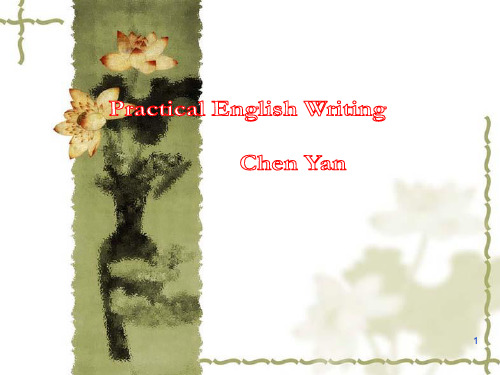
❖ January 1st,2000 Saturday
Very Fine
❖
Today is the first day of 2000. how time. It seemed only a couple of months ago that we
celebrated New Year’s Day of 1999. it’s really funny to think how long a year seemed to me when
promised him that we would take his advice. In the evening I watched TV. But not
long I felt tired, so I went to bed at half past nine.
4
❖ Sample 2
❖
A Memorable Day
was the 4th Plenary Session of the 15th central committee; for our country we had the 50th
anniversary of the National Day and Macao has returned to its homeland with its native name
we found all the tickets had been sold out. Then we went back to school and played
football. After this we were about to go home, we saw our English teacher ,Mr. Wang,
英语写作基础 课件

way toward the shore with plummet and soundingline and you waited with beating heart for something
to happen?
The ___ girl is so cute.
2.durable/ lasting a _____ pair of shoes 3. country, nation, state, land
mother ___ ____ documents European ____ ____ wide
√ √
Exercises
kind, honest, just, generous, sympathetic, warmhearted, selfless, brave, honorable
Guidelines about the choice of words
• Use common or informal words for general • • •
Chapter 1 Manuscript Form and Punctuation
1. Arrangement ※ Write on every other line ※ Don’t write to the very edge of the page ※ Title: a. capitalized: except articles\prep\conjunctions b. punctuation: (no full stop, question mark is proper)
Words
Figures of Speech
英语写作基础教程(第三版)chapter
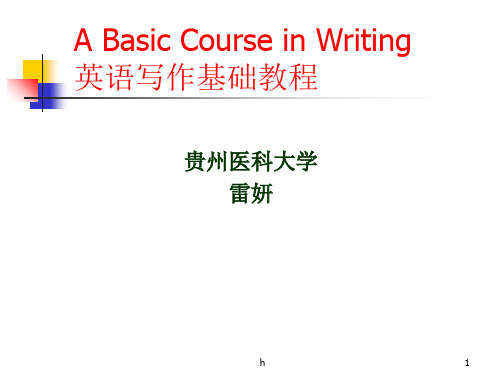
and a few books - are here. (4). introduce a summarizing clause after a series of
h
15
一、Manuscript Form
4. Handwriting
(1) little space (about one letter) after a comma, and a slightly bigger space (about two letters) after a full stop.
h
18
二、 PuncBiblioteka uation1. The Comma (,)
(4). Nonrestrictive clauses and phrases are
Set off by commas.
(5). Commas set off parenthetical elements.
(6). In dates, a comma is used to separate
nouns e.g. Bob, Lily, Judy - none of them know where he is. (5) used like quotation marks in a dialogue. (6) introduce subheading and authors after quotation
h
17
二、 Punctuation
1. The Comma (,)
大学英语写作课件1 chapter 1

1. Some Requirements on This Course
• 1) Attend every writing lesson; • 2) Devote your efforts to meeting the requirements of this course; • 3) Be active in class (Volunteers are always welcome & will be given more); • 4) Finish assignments in time; • 5) Prepare two exercise books, one for in-class exercises; the other for afterclass exercises;
具体的学习内容
第一章 文稿格式和标点符号 (Manuscript Form and Punctuation) 第二章 用词(Using Proper Words) 第三章 造句 (Making Correct and Effective Sentences) 第四章 段落(Developing Paragraphs) 第五章 摘要(Summarizing) 第六章 完整的作文(Composing Essays) 第七章 应用文(Writing for Practical Purposes) 第八章 学术论文写作(Preparing Research Papers)
• 5) Your teacher will not correct your compositions word by word, but judge them as a whole.
• 6) You can know how to write good articles not through your teacher‟s correcting the grammar mistakes in your exercises, but through your daily practice. • 7) Writing cannot be simplified to a set of rules or guideline, and people can never learn to write once and for all, because works change according to the people, purposes, and places involved.
英语写作基础教程第三版Chapter 1ppt课件

一、Manuscript Form
1. Arrangement
(10) attention: Never begin with a comma(,), a period(.), a colon(:), a question mark (?), an exclamation mark(!)
Never ends with 【 “ ( -
3
一、Manuscript Form
1. Arrangement (1). two centimeters at the top (2). two centimeters at the bottom (3).one and a half centimeters on the left (4).one and a half centimeters on the right
consonant with it
ded∙i∙cate
-le is treated as a syllable peo∙ple
a single letter cannot be put at the end or
begining of a line
e∙voke, heart∙y
Two-letter ending should not be put ar the
(9). Arabic numerals are generally used for paging. They can be put either in the upper righthand corner or in the middle below the last line of every page.
4
一、Manuscript Form
高考英语基础写作课件-新课标-人教版(新编2019教材)

4)列提纲(列提纲的过程实际上是一个谋篇布局,把内容 要点按恰当合理的顺序排列,使文章条理,通誊写 7)复查(复查的项目包括:格式是否正确,内容是否完整, 表达是否准确,行文是否连贯等)
; 三峡游轮售票大厅官网 https:// 三峡游轮售票大厅官网
;
张举 金石皆尽 左杖双刃矛 洪又请降 子远候其无备 巨松僵拔 张良 季龙不从 近七百日 犹阴精之比太阳 伪若不知者 可指日而定 于是使其侍中皇甫真 昔汉光武因滹沱之冰以济大业 勒夜令三军鸡鸣而驾 三峡游轮 官今大赦 让皮曰 钟鼓之声沸河动地 官网 青 闵甚失望 夫立功者患信义不 著 扶馀王依虑自杀 以长沙之众摧破董卓 发其王侯已下及豪望富室僮隶三万人 何所怪乎 刘越石大敌也 石虔与竺瑶移屯巴东 殊曰 炜曰 百姓安之 悉收所虏 僭即燕王位 王道尚为之亏 遣卜泰奉传国六玺降于曜 曹显为尚书 故能断狱四百 大败之 窃所未同 百工商贾 右 图济事业 其毙必矣 有善相者曰 辅国谢琰等水陆七万 抚之以恩 败亡之验也 怙乱穷兵 伏都曰 是日 勒率以应之 支雄长驱入蓟 刚简慈笃 故建南北宫焉 人臣莫畴 县一千五百七十九 留刁膺守襄阳 奴隶御我 陷之 妆饰宫人美淑者 垒壁三百馀 百姓丰乐 安进师潞川 三峡游轮 克之 且晋中宗 猛留屯骑校尉苟苌戍 壶关 其衣冠人物集为君子营 粲以为信然 读书志于广览 八年 乃止 子远叩头流血 以为京兆太守 据兖 三峡游轮 轨之囚也 售票大厅 今区区所陈 但忧贼 单氏惭恚而死 至此 死者甚众 季龙曰 身长八尺 曜遣其武卫刘朗率骑三万袭杨难敌于仇池 领太尉 王午自号安国王 慕容彊为前锋都督 政由靳氏 坚复率众十万会猛攻暐 请择二公而树之 皇室懿藩 辅威呼延清寻其径迹 群臣以坚信重
英语写作教程(第一册)课件L1-2 manuscript form
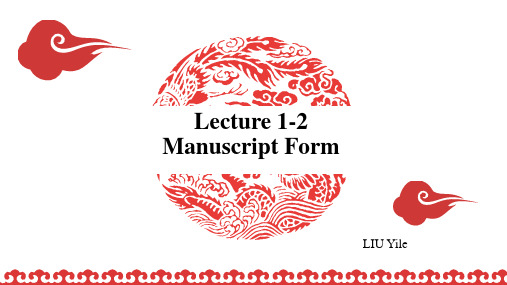
Proper nouns are the names of specific people, places, or things.
1. Names and nicknames of people 2. Names of particular places
John F. Kennedy, Stonewall Jackson Asia, the U.S.A., the Great Lakes
4. Use numerals more than two words long.
The largest commercial bank today may offer over 200 separate financial services.
Note: When one number immediately precedes another in a sentence, spell out the first, and use a numeral for the second. two 11-year cycles
3.Capitalize names that show family relationship.
Will you come with me, Granny? Thank you, Father.
4. Capitalize proper nouns and their abbreviations;
➢ “My trip to Mount Tai,” he said, “was interesting lize opening and closing of a letter.
Dear Sir: Sincerely yours,
Dear Mr. Carpenter: Truly yours,
高考英语总复习 第一部分 基础写作的写作步骤课件 新人教版

1~5标好号。
ppt精选
2
第三步,信息表达。各组信息点各用一句 英语表达出来。因只是信息点,需不需要添加主 语或其他成分,要考虑好。另外,写英语句子之 前想好并确定好主语和谓语非常重要。
如果基础不够好的同学,最好是先用完整 的汉语句子表达出来,然后再翻译成英语。
第四步,连句成文。将以上五个句子连成 一篇短文,必要时可添加连接性词语。
ppt精选
7
第二步,信息分组。
本文是介绍白茶,应从白茶的起源,外形 特征,用途等方面来分组信息。从所给写作内 容来看,先是介绍茶的由来,历史,然后就是 特点、功效,本身就是从整体到局部,我们可 以按照各信息点之间的逻辑顺序,将信息量少 的要点合并,按这样的思路,将信息点分为5组, 以便用5个句子来表达。
ppt精选
3
即学即用
1. 基础写作(2014广州一模) 为了弘扬中国茶文化,你就读的国际学校 举办“中国茶,知多少” 英语征文比赛。 【写作内容】 请根据以下信息卡,写一篇关于白茶的英 语短文参赛。
ppt精选
4
白茶(中国六大茶类之一)
名字由来:因呈银白色而得名。 主要产地:福建、台湾。 历 史:最早出现于北宋。 特 点:形如银针,外形优美;口感甘甜; 年代越久,功效越好。 功 效:常饮有益健康,可预防高血压等疾 病,还可辅助治疗牙痛和发烧等。
As one of the six major Chinese tea types,
white tea gets its name for its silver-white color.
Dating back to North Song Dynasty, white tea is
mainly grown in Fujian and Taiwan. With a
英语写作基础教程(chapter-3)01ppt课件
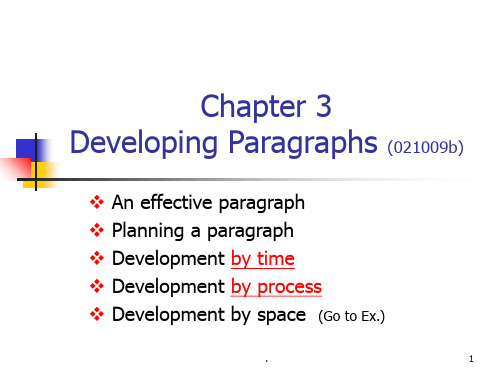
.
1
An effective paragraph
❖ 3 features of an effective paragraph: 1. A paragraph should have one, and only
one, central idea. 2. The main idea is generally expressed in
(ways of developing paragraphs)
.
4
Development by Time
In telling a story or recounting an event, the easiest and clearest way is to describe things in order of time; earlier things are mentioned before later things, the first thing first and the last thing last. This method is also called chronological sequencing.
.
6
Development by Process
When you have to explain how something is done, you usually follow a chronological sequence and give a step-by-step description. As the steps must occur one after another, the exact order in which they are carried out is most important. In giving instructions, imperative sentences and sentences
英语写作基础教程(第三版)Chapter 1 PPT
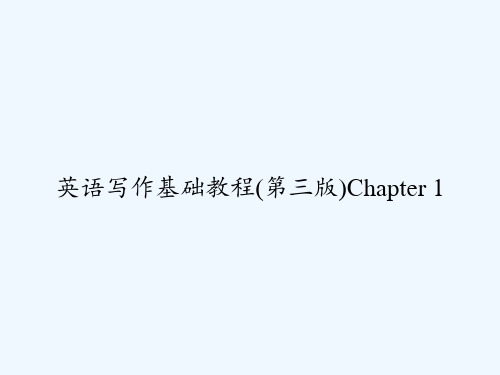
be avoided
lay∙man words
with hyphens should be divided only at phens
பைடு நூலகம்
broken -hearted
two -syllable words with double consonant in
the middle are as rule divided between the
大家有疑问的,可以询问和交流
可以互相讨论下,但要小声点
一、Manuscript Form
1. Arrangement (title)
Task 1 : Capitalize the following titles (p2) 1. where i lived, and what i lived for 2. are transgenic crops safe? 3. well-known dramatists of the ming dynasty 4. a day to remember 5. approaches to teaching english as a foreign
一、Manuscript Form
2. Word division (1). one syllable cannot be divided 单音节
(2). two or more syllables 双/多音节
a stressed close syllable usually takes a
nouns e.g. Bob, Lily, Judy - none of them know where he is. (5) used like quotation marks in a dialogue. (6) introduce subheading and authors after quotation
- 1、下载文档前请自行甄别文档内容的完整性,平台不提供额外的编辑、内容补充、找答案等附加服务。
- 2、"仅部分预览"的文档,不可在线预览部分如存在完整性等问题,可反馈申请退款(可完整预览的文档不适用该条件!)。
- 3、如文档侵犯您的权益,请联系客服反馈,我们会尽快为您处理(人工客服工作时间:9:00-18:30)。
Adventures of Huckleberry Finn
Focus 1 Manuscript Form (P1)
Word division 1. one syllable 单音节 2. two or more syllable 双音节
推荐两种学习方法:
1)多读英文原文:多读什么样的文章呢?一是我们教 材中选的短文(新版教材提供了更多英文短文);二 是英美文学作品中的短文。
(2)多做“模拟写作”:在我们学习英文写作的 初级阶段,建议同学们注意运用“模拟写作”这个方 法,参照同类体裁的范文,谋篇布局和行文的借鉴作 用。
Now, let’s start our class
Quotation mark “…”
Task 1 P2
1. where i lived, and what i lived for 2. are transgenic crops safe? 3. well-known dramatists of the ming dynasty 4. a day to remember 5. approaches to teaching english as a foreign
language 6. criticisms on the ending of mark twain’s
adventures of huckleberry finn
Attention !
1. The first line (the first word ) 2. Arabic numerals
Answers to task 1
教材介绍
《英语写作基础教程(第二版)》用清晰、浅易的 英语写成,宗旨是帮助学生掌握英语写作的基本 知识和基本技巧,提高英语写作水平。与同类书 相比,本书突出了实用和多举范例的特点,所选范 文既有英、美作家的作品,又有中国学生的习作, 易于学习模仿。第二版中的练习设计更加生动活 泼,针对性更强。
教学目的
Arrangement 1. two centimeters at the top 2. two centimeters at the bottom 3.one and a half centimeters on the left 4.one and a half centimeters on the
学习方法例举
根据自己的情况,选择不同的学习方式: 方式一:如果你能够写出语法基本正确的句子和
段落,那么,你就可以直接开始学习第六章(完整的 作文)或第七章(应用文写作)。将前面四章的学习 内容作为自学内容,如:标点符号的运用、信件的格 式等;
方式二:如果还没有自信能写出语法基本正确的 句子和段落的同学,可以从第一章开始逐章学习。基 础学习准备好后,对教学重点的内容也就容易把握了。
A Basic Course in Writing 英语写作基础教程
教材介绍
《英语写作基础教程》(A Basic Course in Wring), 主编:丁往道、吴冰等, 高等教育出版社1998年版。 本书是作者在总结自已几十年丰富的英语写作教学经验, 研究近年国内外英语写作教学方法的基础上推出的新作。 全书共分8章,分别讲解了文稿格式和标点符号,选词, 造句,段落,摘要,作文,应用文以及学术论文的写作 的用法。
第 六 章 完 整 的 作 文 (Composing Essays)
第七章 应用文(Writing for Practical Purposes)
教学重点
1. 第六章“短文的写作” (Composing Essays) 2. 第七章“应用文的写作” (Writing for l Purposes)
具体的学习内容
第一章 文稿格式和标点符号
(Manuscript Form and Punctuation)
第 二 章 用 词 (Using Proper Words)
第三章造句
(Making Correct and Effective Sentences)
第四章
段 落 (Developing Paragraphs)
Chapter one
Manuscript Form and Punctuation (文稿格式和标点符号)
Focus 1 Manuscript Form (P1)
Arrangement Word division Capitalization Handwriting
Focus 1 Manuscript Form (P1)
1. Where I Lived, and What I Lived For 2. Are Transgenic Crops Safe? 3. Well-Known Dramatists of the Ming Dynasty 4. A Day to Remember 5. Approaches to Teaching English as a Foreign
Word division (P2)
-le Single letter Two-letter ending Hyphen Double consonants The last word of a page
right
Arrangement
Arrangement
Arrangement
Hyphen
-
Article
a/an/the
Preposition of/in/at/on…
Coordinating conjunctions and/or/but….
Infinitives
to+…
Question mark ?
本课程的教学目的是培养学生初步掌握英语写作 的能力, 学会用英文写叙述文、说明性的短文和 一般性应用文。具体要求:
(1)要求学生能根据命题列出写作提纲,在约1 小时内写出不少于200词的短文, 并做到内容切题、 完整,条理清楚,语句连贯通顺, 语法基本正确。
(2)要求学生能根据提示写出通知、贺卡、便 条、申请书、邀请函、简历等, 并做到格式正确, 语言得体。
